英语时态讲解讲义
英语时态8种基本时态讲解.ppt课件

8.过去完成时 表示动作发生在过去某一时间之前已经完成的动作或状态, 强调“过去的过去”, 常与 by the time, by the end of…,before , by 等引导时间的状语连用。
基本结构 主语+ had + 动词过去分词 + 其他成分 When I got to the cinema yesterday the film had begun already. He had learned English before he came here.
现在完成时与一般过去时的区别: 1)现在完成时侧重于对现在的影响;而一般过去时侧重于某一动作发生在过去某个时间或某段时间。即现在完成时侧重于现在的结果,而一般过去时侧重于动作发生的时间。例如:
I have seen the film. 我看过这部电影。(现在我仍记得电影的内容) I saw the film three days ago. 三天前我看了这部电影。(强调是三天前,而不是别的什么时候看的电影)
be going to含有“打算,准备”的意思,而will则没有这个意思, She is going to lend us her book. He will be here in half an hour.
be about to+V.原形(意为马上做某事,在时间上指最近的将来) I am about to leave school. 不能与表示时间的副词连用。 They are about to set out.(√) They are about to set,变y为i加-ed. study----studied carry----carried cry----cried try----tried d)以元音字母+y结尾的单词直接加-ed. play----played stay----stayed
时态讲义
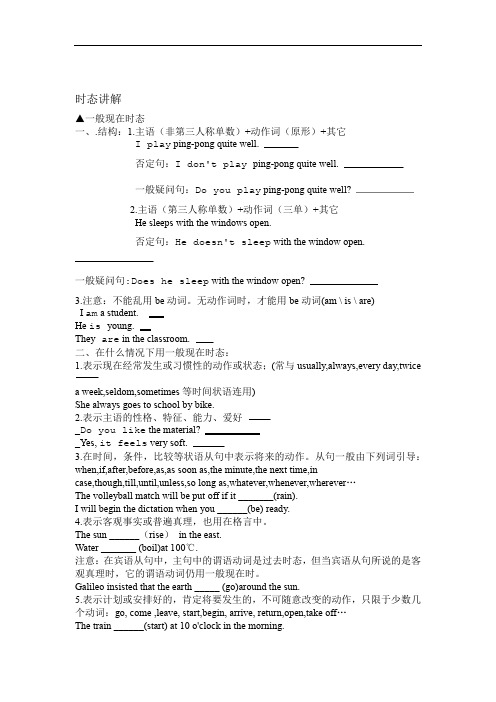
时态讲解▲一般现在时态一、.结构:1.主语(非第三人称单数)+动作词(原形)+其它I play ping-pong quite well.否定句:I don't play ping-pong quite well.一般疑问句:Do you play ping-pong quite well?2.主语(第三人称单数)+动作词(三单)+其它He sleeps with the windows open.否定句:He doesn't sleep with the window open.一般疑问句:Does he sleep with the window open?3.注意:不能乱用be动词。
无动作词时,才能用be动词(am \ is \ are)I am a student.He is young.They are in the classroom.二、在什么情况下用一般现在时态:1.表示现在经常发生或习惯性的动作或状态;(常与usually,always,every day,twicea week,seldom,sometimes等时间状语连用)She always goes to school by bike.2.表示主语的性格、特征、能力、爱好_Do you like the material?_Yes, it feels very soft.3.在时间,条件,比较等状语从句中表示将来的动作。
从句一般由下列词引导:when,if,after,before,as,as soon as,the minute,the next time,incase,though,till,until,unless,so long as,whatever,whenever,wherever…The volleyball match will be put off if it _______(rain).I will begin the dictation when you ______(be) ready.4.表示客观事实或普遍真理,也用在格言中。
《现在进行时》 讲义

《现在进行时》讲义一、现在进行时的定义和构成现在进行时表示正在进行的动作或存在的状态。
它的构成是“be 动词(am/is/are)+动词的现在分词”。
比如:“I am reading a book”(我正在读一本书。
)在这个句子中,“am reading”就是现在进行时的结构,“am”是 be 动词,“reading”是动词“read”的现在分词形式。
二、现在进行时的基本用法1、表示此刻正在进行的动作这是现在进行时最常见的用法。
当我们想要描述此时此刻正在发生的事情时,就会用到现在进行时。
例如:“She is cooking dinner in the kitchen”(她正在厨房做晚饭。
)“ They are playing football on the playground”(他们正在操场上踢足球。
)2、表示现阶段正在进行的动作有时候,一个动作不是在此时此刻正在发生,而是在当前这段时间内持续进行的。
比如:“I am studying English these days”(这些天我正在学习英语。
)“He is writing a novel this month”(这个月他正在写一部小说。
)3、与 always 等词连用,表示反复出现或习惯性的动作,常带有感情色彩“ She is always talking in class”(她总是在课堂上讲话。
)这里用现在进行时表达了说话人的不满情绪。
“ He is constantly changing his mind”(他老是改变主意。
)此句中现在进行时突出了一种厌烦的感觉。
三、现在分词的构成规则1、一般情况下,在动词词尾直接加 ing例如:work working ; play playing ; study studying2、以不发音的字母 e 结尾的动词,去掉 e 再加 ing例如:write writing ; make making ; take taking3、以重读闭音节结尾,且末尾只有一个辅音字母的动词,双写末尾的辅音字母再加 ing例如:run running ; swim swimming ; sit sitting4、少数几个以 ie 结尾的动词,要变 ie 为 y 再加 ing例如:lie lying ; die dying ; tie tying四、现在进行时的否定句和疑问句1、否定句在 be 动词后面加 not 即可构成否定句。
2025届高考英语语法复习一般过去时知识讲解讲义
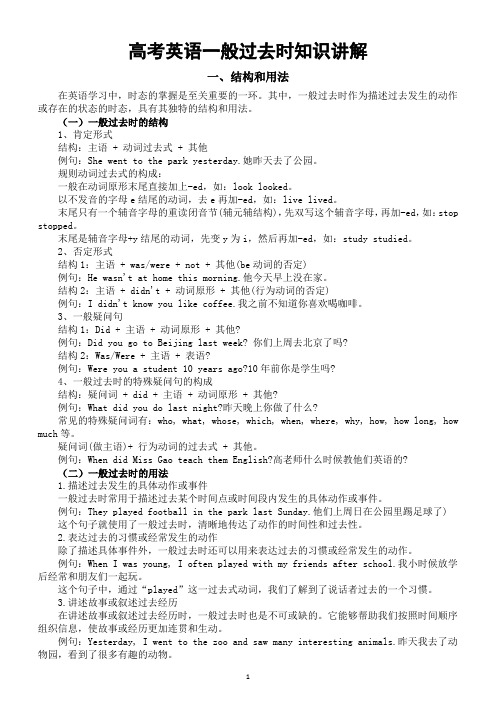
高考英语一般过去时知识讲解一、结构和用法在英语学习中,时态的掌握是至关重要的一环。
其中,一般过去时作为描述过去发生的动作或存在的状态的时态,具有其独特的结构和用法。
(一)一般过去时的结构1、肯定形式结构:主语 + 动词过去式 + 其他例句:She went to the park yesterday.她昨天去了公园。
规则动词过去式的构成:一般在动词原形末尾直接加上-ed,如:look looked。
以不发音的字母e结尾的动词,去e再加-ed,如:live lived。
末尾只有一个辅音字母的重读闭音节(辅元辅结构),先双写这个辅音字母,再加-ed,如:stop stopped。
末尾是辅音字母+y结尾的动词,先变y为i,然后再加-ed,如:study studied。
2、否定形式结构1:主语 + was/were + not + 其他(be动词的否定)例句:He wasn't at home this morning.他今天早上没在家。
结构2:主语 + didn't + 动词原形 + 其他(行为动词的否定)例句:I didn't know you like coffee.我之前不知道你喜欢喝咖啡。
3、一般疑问句结构1:Did + 主语 + 动词原形 + 其他?例句:Did you go to Beijing last week? 你们上周去北京了吗?结构2:Was/Were + 主语 + 表语?例句:Were you a student 10 years ago?10年前你是学生吗?4、一般过去时的特殊疑问句的构成结构:疑问词 + did + 主语 + 动词原形 + 其他?例句:What did you do last night?昨天晚上你做了什么?常见的特殊疑问词有:who, what, whose, which, when, where, why, how, how long, how much等。
八大时态讲解

一般将来时的注意点:
be going to 与 will /shall区别: be going to 指当前的、已计划过或思考过的意图 和打算;
如:I am going to listen to music. (我打算听音乐 )
will /shall 表示未事先思考或为计划过的意图 如:It will be Christmas soon .(很快就圣诞节了 )
3.一般将来时态(The Simple Future Tense)
概念:表示将来某个时间要发生的动作或存
在的状态
谓语动词形式
:12..
will/shall+do am/is/are going
to+do
3. am/is/are + doing
常用时间状语 :
tomorrow, in three days,this…,
• 将来完成时: We will have had our exam by September 20.
• 过去将来完成时: He told them he would have finished by 9 o’clock.
英语的动词时态(完成进行)
• 现在完成进行时: Obviously she’s been crying. It has been snowing all night. The ground is covered with thick snow.
• 一般将来时: We will have a test next month. He is going to buy her some flowers.
• 一般过去将来时: He was sixty-eight. In two years he would be seventy. I knew you would agree.
英语语法16种时态介绍ppt课件
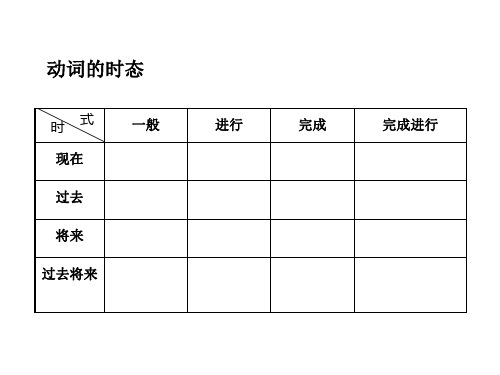
“意愿”,但不表示时态。
If you will accept my invitation and come to our party, my family will be pleased.如果你愿意接受并 参加我们的舞会,我的家人会非常高兴。
6)祈使句中 ( to give directions or instructions ) Go down the street, and then take the second turning on
the left.
知识扩展:一般现在时表将来
1)下列动词:come, go, arrive, leave, start, begin, return的一般 现在时表将来。这主要用来表示在时间上已确定或安排好的 事情 ( timetabled or fixed events )。 The train leaves at six tomorrow morning. When does the bus start? It starts in ten minutes.
You are always changing your mind. You are always doing well
He’s always asking the same question. 6. 状态动词的进行时后面接形容词brave; careful; stupid; clever; foolish; polite; kind; shy等时,为 主语所表现的非一般惯性特点或故意的行为。
6 )在the more…the more…句型中,从句也要用一 般现在时取代将来时。
(完整版)英语语法八大时态复习讲义

英语语法八大时态复习讲义一般现在时 1.一般现在时态结构动词的第三人称单数+其他动词原形肯定句式: 主语+/ 动词原形+其他否定句式: 主语+(助动词)don't/doesn't + 动词原形+其他一般疑问句式: Do/Does+主语+ 主语+do/does not (否)No, 简略回答: (肯)Yes,主语+do/doesdoesn't = does not 缩写形式: don't = do not例句:I usually leave home for school at 7 every morning. He often goes swimming in summer.一般现在时的用法2.)表示经常的或习惯性的动作,常与表示频度的副词连用。
1sometimes, every week (day, year, 、、never usually、seldom always常用的频度副词有:、often、助动词系动词、。
频度副词在句中通常放在行为动词之前,month…), once a week, on Sundays 之后。
: He often goes swimming in summer.他夏天经常游泳。
例如I usually leave home for school at 7 every morning. 每天早上我七点离开家。
2)表示现在的状态。
My father is at work.He is very busy. 我父亲在工作,他很忙。
例如:The boy is twelve. 这男孩十二岁。
3)表示主语具备的性格、特征和能力等。
All my family love football .我全家人都喜欢足球。
例如:我妹妹总是乐于助人。
My sister is always ready to help others . 安英语写得不错,讲的可不行。
Ann writes good English but does not speak well. 表示客观真理、客观存在、自然现象。
熟练掌握英语16大时态讲义-2024届高考英语一轮复习
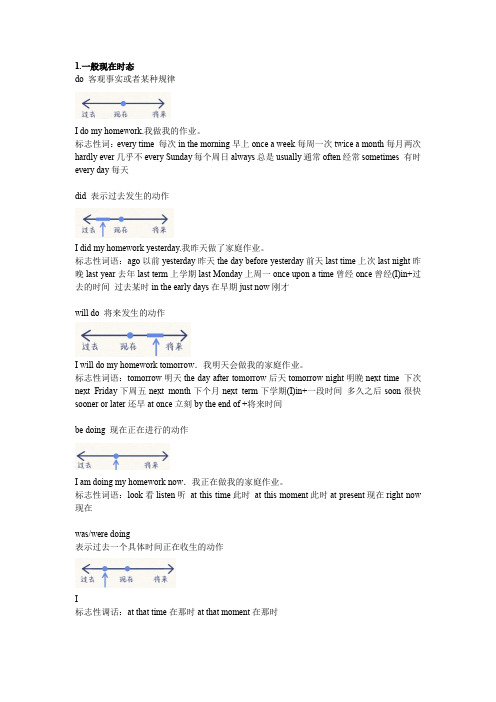
1.一般现在时态do 客观事实或者某种规律I do my homework.我做我的作业。
标志性词:every time 每次in the morning早上once a week每周一次twice a month每月两次hardly ever几乎不every Sunday每个周日always总是usually通常often经常sometimes 有时every day每天did 表示过去发生的动作I did my homework yesterday.我昨天做了家庭作业。
标志性词语:ago以前yesterday昨天the day before yesterday前天last time上次last night昨晚last year去年last term上学期last Monday上周一once upon a time曾经once曾经(I)in+过去的时间过去某时in the early days在早期just now刚才will do 将来发生的动作I will do my homework tomorrow.我明天会做我的家庭作业。
标志性词语:tomorrow明天the day after tomorrow后天tomorrow night明睌next time 下次next Friday下周五next month下个月next term下学期(I)in+一段时间多久之后soon很快sooner or later还早at once立刻by the end of +将来时间be doing 现在正在进行的动作I am doing my homework now.我正在做我的家庭作业。
标志性词语:look看listen听at this time此时at this moment此时at present现在right now 现在was/were doing表示过去一个具体时间正在收生的动作I标志性调话:at that time在那时at that moment在那时will be doing在将来正在发生的动作I will be doing my homework at 9:00.9点的时候,我会正在政作业。
英语时态讲解讲义PPT课件

★表示主语现在的状态、能力、爱好、职业、性格。
His mother is a doctor. ★表示客观真理、科学真理、自然界的普片现象或众人所知的
客观事实。
The moon goes around the earth. ★表示格言或警句。
All men die. ★在when, as soon as, before, while, so (as) long as等引导的时间
实意动词
V-s
主语是第三人称单数 + V-es
V-ies
have的第三人称单数为has
2021
7
1. He often __g_oe_s__ (go) to school on foot. 2. His character __is__ (be) like his father. 3. I will tell you when he _c_o_m_e_s(come) back. 4. Good begun __is__ (be) half done. 5. Bitter pills __h_a_v_e(have) wholesome effects. 6. As the old saying _g_o_e_s_ (go). 7. Light _tr_a_v_e_ls(travel) faster than sound. 8. Here c_o_m__es_ (come) the bus. 9. There __go_e_s__ (go) the bell. 10. If it d_o_e_s_n_’t_r_a_in( not rain) tomorrow, we’ll go to have a picnic.
动词的时态讲义及教案
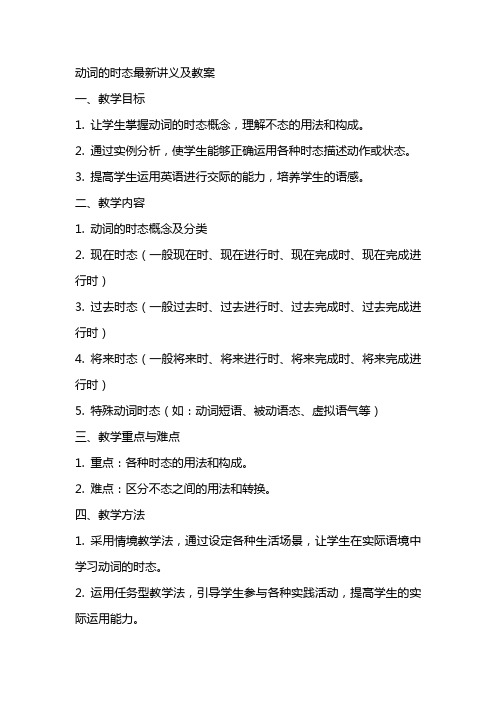
动词的时态最新讲义及教案一、教学目标1. 让学生掌握动词的时态概念,理解不态的用法和构成。
2. 通过实例分析,使学生能够正确运用各种时态描述动作或状态。
3. 提高学生运用英语进行交际的能力,培养学生的语感。
二、教学内容1. 动词的时态概念及分类2. 现在时态(一般现在时、现在进行时、现在完成时、现在完成进行时)3. 过去时态(一般过去时、过去进行时、过去完成时、过去完成进行时)4. 将来时态(一般将来时、将来进行时、将来完成时、将来完成进行时)5. 特殊动词时态(如:动词短语、被动语态、虚拟语气等)三、教学重点与难点1. 重点:各种时态的用法和构成。
2. 难点:区分不态之间的用法和转换。
四、教学方法1. 采用情境教学法,通过设定各种生活场景,让学生在实际语境中学习动词的时态。
2. 运用任务型教学法,引导学生参与各种实践活动,提高学生的实际运用能力。
3. 采用讲解与练习相结合的方法,让学生在课堂内外巩固所学知识。
五、教学步骤1. 引入:通过问答方式引导学生回顾已学过的动词时态知识。
2. 新课讲解:讲解本节课要学习的时态,如一般现在时、现在进行时等。
3. 实例分析:用具体例子解释不态的用法,让学生加深理解。
4. 课堂练习:设计相关练习题,让学生即时巩固所学知识。
5. 小组讨论:分组让学生讨论如何运用所学时态进行实际交流。
6. 课堂小结:总结本节课所学内容,强调重点和难点。
7. 课后作业:布置相关作业,让学生课后巩固复习。
8. 教学评价:及时了解学生掌握情况,对教学进行调整。
六、教学活动设计1. 互动游戏:设计一个动词时态的互动游戏,如“时态猜猜乐”,让学生在游戏中复习和巩固不态的用法。
2. 角色扮演:让学生分组进行角色扮演,模拟不同场景下的动词时态运用,如在餐馆、学校、家庭等场景中运用不态描述动作。
3. 故事创作:让学生运用所学时态创作一个简短的故事,要求故事中包含不态的句子,以此检验学生对动词时态的掌握程度。
时态语态讲义
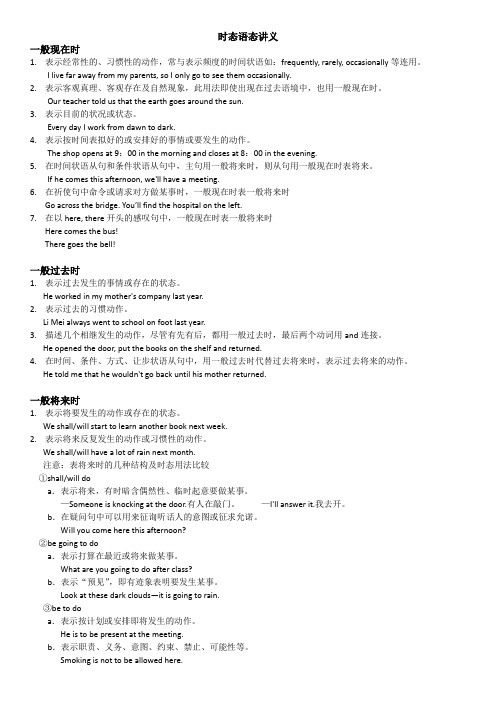
时态语态讲义一般现在时1.表示经常性的、习惯性的动作,常与表示频度的时间状语如:frequently, rarely, occasionally等连用。
I live far away from my parents, so I only go to see them occasionally.2.表示客观真理、客观存在及自然现象,此用法即使出现在过去语境中,也用一般现在时。
Our teacher told us that the earth goes around the sun.3.表示目前的状况或状态。
Every day I work from dawn to dark.4.表示按时间表拟好的或安排好的事情或要发生的动作。
The shop opens at 9:00 in the morning and closes at 8:00 in the evening.5.在时间状语从句和条件状语从句中,主句用一般将来时,则从句用一般现在时表将来。
If he comes this afternoon, we'll have a meeting.6.在祈使句中命令或请求对方做某事时,一般现在时表一般将来时Go across the bridge. You’ll find the hospital on the left.7.在以here, there开头的感叹句中,一般现在时表一般将来时Here comes the bus!There goes the bell!一般过去时1.表示过去发生的事情或存在的状态。
He worked in my mother's company last year.2.表示过去的习惯动作。
Li Mei always went to school on foot last year.3.描述几个相继发生的动作,尽管有先有后,都用一般过去时,最后两个动词用and连接。
四大时态讲义(全)
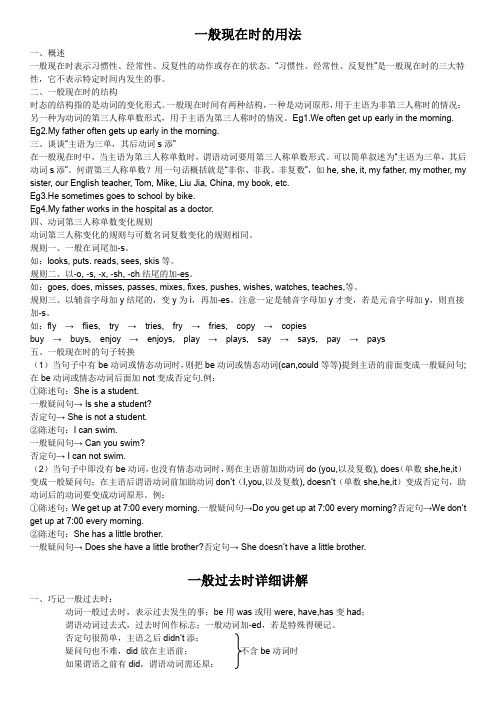
一般现在时的用法一、概述一般现在时表示习惯性、经常性、反复性的动作或存在的状态。
“习惯性、经常性、反复性”是一般现在时的三大特性,它不表示特定时间内发生的事。
二、一般现在时的结构时态的结构指的是动词的变化形式。
一般现在时间有两种结构,一种是动词原形,用于主语为非第三人称时的情况;另一种为动词的第三人称单数形式,用于主语为第三人称时的情况。
Eg1.We often get up early in the morning. Eg2.My father often gets up early in the morning.三、谈谈“主语为三单,其后动词s添”在一般现在时中,当主语为第三人称单数时,谓语动词要用第三人称单数形式。
可以简单叙述为“主语为三单,其后动词s添”。
何谓第三人称单数?用一句话概括就是“非你、非我、非复数”,如he, she, it, my father, my mother, my sister, our English teacher, Tom, Mike, Liu Jia, China, my book, etc.Eg3.He sometimes goes to school by bike.Eg4.My father works in the hospital as a doctor.四、动词第三人称单数变化规则动词第三人称变化的规则与可数名词复数变化的规则相同。
规则一、一般在词尾加-s。
如:looks, puts. reads, sees, skis等。
规则二、以-o, -s, -x, -sh, -ch结尾的加-es。
如:goes, does, misses, passes, mixes, fixes, pushes, wishes, watches, teaches,等。
规则三、以辅音字母加y结尾的,变y为i,再加-es。
注意一定是辅音字母加y才变,若是元音字母加y,则直接加-s。
英语十六大时态讲解课件(共48张)

• 重点提示
• 现在进行时的这一用法与一般现在时的区别 在于后者只是说明事实,而前者则往往带有 说话人的感情,如赞扬,遗憾,讨厌或不满 等。比较: • Jack comes late for school.(只说明事实) • Jack is always coming late for school.(不是说 活人对jack的不满)
• 重点提示 • Will 和 be going to 都可以表示某种意愿,有时 候可以互换使用,但be going to往往表示事先 经过考虑的打算; will 多表示意愿,决心,因 而有时又不能交替使用。如: • I’ll tell you something that does sound strange. • (这里可以与am going to互换使用) • He is working hard and is going to try for the college entrance exam. • (不能用will替换)
• 3, be +to • (1)这一结构常用来表示按计划或安排即将 发生的动作 • We are to see our English teacher next week.
• (2)表示职责,义务,意图,约定,禁止, 可能性等 • Smoking is not to be allowed here.
现在进行时
• 英语动词进行时的主要特点是它所表示的动作 具有持续性,暂时性和未完成性. • 1, 构成: is/am/are doing • 2, 用法 • 表示说话时正在发生或进行着的动作 • Don’t disturb him. He’s listening to the weather forecast. • I’m sitting on a rock near the river with my friends.
高一英语时态讲解ppt课件.ppt

tomorrow.
(否定句)
Will I/ you/ she/ we/ they watch TV tomorrow?
(一般疑问句)
肯定回答:Yes, I/ you/ she/ we/ they will. 否定回答:No, I/ you/ she/ we/ they will not(won’t).
行 时
肯定:Yes,he/she is. 否定结:构N:o, he/she isn’t.
Sb. +is /are /am + v-ing.(肯定句)
SWb.e+/Tishne’ty//aYroenu’ta/raemwnaottc+hvin-igngT.(V 否no定w句.()肯定句)
IsW/Aer/eT+hSeby./+Yov-uinagr?e(n一’t w般a疑tc问hi句ng)TV now.(否定句) 肯A定re回w答e/t:heYeys/y, osbu. +wisa/tacrhe/inamg .TV now(?一般疑问句)
认识到了贫困户贫困的根本原因,才 能开始 对症下 药,然 后药到 病除。 近年来 国家对 扶贫工 作高度 重视, 已经展 开了“ 精准扶 贫”项 目
一般过去时
I watched TV last night
I watch TV everyday. 一般现在时
I am watching TV now. 现在进行时
一 般
肯定回答: Yes , I/we do. 否定回答:No, I/we don’t现.
He He
/ /
She She
wdoaetcshne’tswTaVtcehveTrVydeavye.r(yd肯ay定. 句()否定句)在时
16种英语时态讲解PPT课件
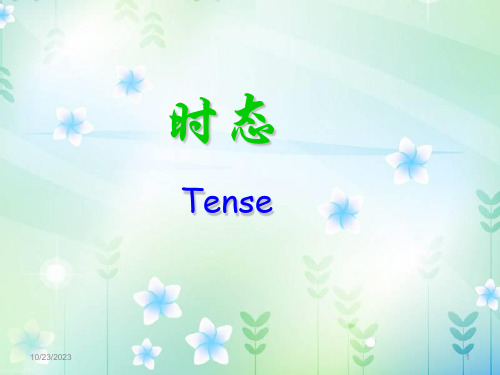
10/23/2023
8
五、现在进行时态
现在进行时的基本用法
形式: am/is/are + doing
用法1: 表示说话此刻动作正在进行.
• He is not available now. he is talking on the phone.
• Please don’t make so much noise. I am studying.
时态
Tense
10/23/2023
1
一、时态概述
16种时态 一般动作
现在 一般现在
过去 一般过去
进行动作 现在进行 过去进行
完成动作 现在完成 过去完成
完成进行动 现在完成
作
进行
过去完成 进行
将来 一般将来 将来进行 将来完成 将来完成
进行
过去将来 一般过去将来 过去将来进行 过去将来完成 过去将来完成
此用法常与一些表示动作频率的时间副词连用(副词放在be动词之 后, 实义动词之前).
1) 表示肯定的频率副词: always, frequently, usually, sometimes, often, occasionally, generally 等.
2) 表示否定的频率副词: never, seldom, rarely 等.
10/23/2023
6
四、一般将来时态
一般将来时的基本用法
形式:
will do 或be going to do
用法1: 表示预测将要发生某事,用will或be going to do.
1) be going to 特别意指根据目前的明显迹象来推断某件事 要发生; will 则只是表名说话人认为或相信某件事要发生
英语八大时态PPT课件(详细版)

A
知识导航
种类
一般现在时 一般过去时 一般将来时 现在进行时 现在完成时 过去进行时 过去完成时 过去将来时
构成
do/does did will/shall+动词原形 am/is/are + doing have/has+过去分词 was/were + doing had+过去分词 would/should+动词原 形
A
4
※表示主语所具有的特征、性格、 能力、状态等
She is a middle school student. She looks a little worried. ※某些以here/there开头的句子 中,用一般现在时表正发生的动 作
Here comes the bus.
A
5
※表示将来发生的、时刻表上不改变的事 The train leaves Hunan at five o’clock. ※特殊情况 在时间状语从句和条件状语从句中,若主 句用一般将来时,则从句用一般现在代替 将来。(主将从现)
A
21
四、一般将来时
1、构成 一般将来时态由
“will/shall+动词原形”构成,me to ask Mary for help.
A
22
2、其他表示
※be going to +动词原形:表示 说话人主观的打算或预测。 I am going to look for a job here. It is going to be a fine day for camping tomorrow.
【小试牛刀】 他们昨天这个时候正在吃晚餐。
They were having dinner this time yesterday.
英语时态讲解课件.ppt
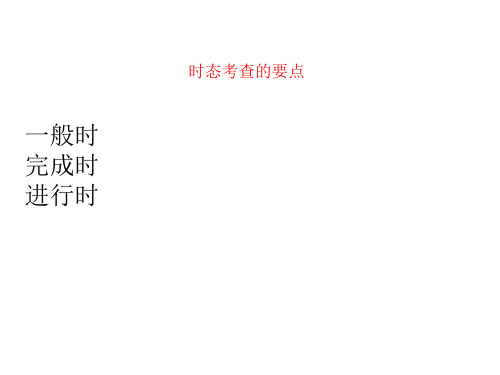
(2)现在完成时表示过去已经开始,持续到现在,也许还会持续下 去的动作或状态。可以和表示从过去某一时刻延续到现在(包括现 在在内)的一段时间的状语连用。 如:for和since,以及 so far, now, today, this week(month, year) 等。
① I haven’t seen her these days. ② She has learnt English for 3 years. ③ They have lived here since 1990. ④ What has happened to the USA in the last 350 years? 注意:表示短暂时间动作的词,如come, go, die, marry, buy等的完 成时不能与for, since等表示一段时间的短语连用。
-ing形式 going, looking
writing, taking
get, sit, put, run, getting, sitting,
begin
running,
beginning
现在完成时
1.现在完成时的构成:助动词have (has) + 动词的过去分词(done)
2.现在完成时的用法: (1)现在完成时表示过去发生或已经完成的某一动作对现在造成 的影响或结果。通常与表示包括现在在内的时间副词just,already, before, yet, never, ever ,up till now 等状语连用。 特别注意的是in the past/last+一段时间。 例如:
A. had met B. have met C. met
D. meet
答案B ;首先本题后句强调对现在的影响,我知道她的模样,你不 用描述。再次,several times告知为反复发生的动作,因此用现在 完成时。
英语时态介绍PPT课件

过去将来时
概念:指将发生的行为或存在状态,以及在过去某一特定时间做某事的意图、 计划或准备。 时 间 状 语 : t h e n e x t d a y ( w e e k , m o n t h , y e a r… ) , s o o n , i n a f e w m i n u t e s 等等。
现在完成时
概念:过去发生或完成的一个动作在现在的效果或结果,或从过去开始并持续 到现在的一个动作或状态。 时 间 状 语 : re c e n t l y , l a t e l y , s i n c e … f o r… , i n t h e p a s t f e w y e a r s 等 等 。
英语时态介绍PPT课件
演讲人
目录
01. 一般现在时 03. 现在进行时 05. 过去完成时 07. 过去将来时
02. 一般过去时 04. 现在完成时 06. 一般将来时
一般现在时
概念:一种频繁、反复出现的动作或行为和当前状态。 时间状语:always,usually,often,sometimes,everyweek等等。
一般过去时
概念:在过去某个时间发生的动作或状态;过去的习惯或惯例的行为、动作。 时间状语:ago,yesterday,thedaybeforeyesterday,lastweek等等。
现在进行时
概念:指在当前阶段或说话时发生的动作和行为。 时间状语:now,atthistime,thesedays等等。 4. 过去进行时 概念:在过去某一特定时间或时刻正在发生或正在发生的行为或动作。 时间状语:atthistimeyesterday,atthattime或以when引导的谓 语动词是一般过去时的时间状语等。
- 1、下载文档前请自行甄别文档内容的完整性,平台不提供额外的编辑、内容补充、找答案等附加服务。
- 2、"仅部分预览"的文档,不可在线预览部分如存在完整性等问题,可反馈申请退款(可完整预览的文档不适用该条件!)。
- 3、如文档侵犯您的权益,请联系客服反馈,我们会尽快为您处理(人工客服工作时间:9:00-18:30)。
3. 动词词尾为ie时, 将ie变为y,再加ing. die—dying, lie—lying, tie--tying
4. 动词以重读闭音节结尾, 末尾只有一个辅音字母时,双写 后再加ing
Three. The Simple Past Tense
★ 表示过去发生的动作或存在的状态。常与表示过去的时间状 语连用。如:yesterday, the day before yesterday, last ( week, night, month, year, season.),ago,in + 过去的时间,in those days, at that moment等 ★ 表示过去经常、习惯性的动作、存在的状态或行为。 ★ 表示已故人所作的事情,也表示主语过去所具有的性格、能 力等。 went (go) swimming when he was a young boy. 1. He usually _____ wrote (write) a lot of funny stories for kids. 2. The late writer ______
The usage and concept of all kinds of tenses
One. The Simple Present Tense
★表示现在经常性、习惯性的动作或状态。常与一下表示频率 的时间状语连用。always, often, usually, sometimes, every week ( day, year, month, morning等)。 ★表示主语现在的状态、能力、爱好、职业、性格。 His mother is a doctor. ★表示客观真理、科学真理、自然界的普片现象或众人所知的 客观事实。 The moon goes around the earth. ★表示格言或警句。 All men die. ★在when, as soon as, before, while, so (as) long as等引导的时间 以及if, in case, even if,unless等引导的条件状语从句中用一 般现在时表示将来的动作。 ★其他。
come-be, go out -be out, leave-be away (from), begin-be on, buy-have, borrow-keep , join-be a member / die-be dead, become-be, open (v.)-be open 等。 I have studied English for three years. She has had the book for two months. He has made some friends since he came to China.
1. 一般现在时态 2. 一般过去时态
The simple present tense or the present tense The past tense The present continuous tense The simple future tense The present perfect tense The past perfect tense The past continuous tense The future continuous tense The future perfect tense
★现在完成时表示过去已经发生的动作或存在的状态延续到现在, 有可能还将继续持续下去。在表示这种意义时,句中的动词通常 是“延续性动词”,一些“瞬间动词”常用相对应的“延续性动 词”来代替,常见的有:buy—have, borrow—keep, come—be
here, die—be dead等。(句中的时间常由for或since引导。)
1.They’ve already won a game. 2. Have you got the plan ready yet? ----No, not yet. 3. I have just got a letter. 4. Have you ever seen each other before?
Four. The Simple Future Tense
★一般将来时:表示将来某个时间将要发生的动作或存
在的状态,也表示将来经常或反复发生的动作,常与 tomorrow, next , the day after tomorrow, in +时间段,in the future, from now on等表示将来的时间状语连用。
★表示移动性的瞬间动词用于进行时表示将来。类似的
动词有go, leave, start, begin,come等。
★在时间或条件状语从句中,如果主句用一般将来时态,
则从句用一般现在时态表示将来。
Five. The Past Continuous Tense
★表示在过去某一时刻或某一阶段正在发生的动作。
14.过去完成进行时。 主语 + had been v--ing
15.将来完成进行时。 主语 + shall/will have been v-ing 16.过去将来完成进行时。 主语 + should + have been +v-ing
(用语第一人称)
主语 + would + have been +v-ing (用语其它人称)
The present perfect continuous tense The past perfect continuous tense The future perfect continuous tense
14. 过去完成进行时
15. 将来完成进行时
16. 过去将来完成进行时 The t future perfect continuous tense
1. 2. 3. 4. 5. 6. 7. 8. 9.
一般现在时态 一般过去时态 现在进行时态 一般将来时态 现在完成时态 过去完成时态 一般过去进行时态 将来进行时 将来完成时
主语 + be 或主语 + do/does 主语 + v—ed +其它 主语 + be (am, is, are) + v-ing 主语 + will/ be going to + v 主语 + have/has+过去分词 主语 + had +过去分词 主语 + was/were +v-ing 主语 + should/would be doing 主语 + shall/will have +过去分词
The changing rules of the present participle
1.一般直接在动词后加 ing. play--playing
2. 以不发音的字母e结尾的,去e再加 ing. come—coming be—being, flee—fleeing, dye—dyeing, shoe--shoeing
10. 一般过去将来时。
主语 + would/should +v 主语 + was/were going to do
11.过去将来进行时。 主语 + should/would be v--ing 12.过去将来完成时。 主语 + should/would have done sth 13.现在完成进行时。 主语 + have/has been v--ing
Explanation of English Tenses
Wang Zhenghao Teachers’ Training Center of Chengguan District
1. Do you know how many kinds of tenses in English? Perhaps you can say it in Chinese? 2. What are they?
Two. The Present Continuous Tense
★表示说话人说话瞬间正在进行或发生的动作。常与now, look, listen等次连用。 ★ 表示目前一段时间正在进行或发生的动作,不一定是说话瞬 间。常与at present(目前), at these days(最近), this week(本周)等。
Seven. The Past Perfect Tense
★过去完成时是表示在过去某一时间或某一动作之前已经发
生或完成的动作、事情。它表示的是发生在“过去的过去” 的动作,只有在和过去某个时间或动作相比较的时候才会使 用过去完成时。与by, before, by the end of引导的表示过去的 时间状语连用。
Six. The Present Perfect Tense
★现在完成时表示过去发生的动作对现在造成的影响或结果。在 表示这种意义时,句中的动词通常是“瞬间动词”。(常用的 时间副词有:already,yet,just,ever,never,before等,其中 already,just,ever,never等常用于助动词have/has后;yet, before等用于句末,且yet用于否定句和疑问句中。)
at ten yesterday morning, at this time yesterday, from seven to nine last night,等时间状语以及while, when引导的时间状语连用。 1.I was reading a book when the bell rang. 2. I was watching TV while my mother was cooking. 3. At this time yesterday, he was playing football.
1. Look! A train is coming. 2. Listen! He is playing the guitar. 3. What lessons are you studying this week? 4. What are you doing these days?
